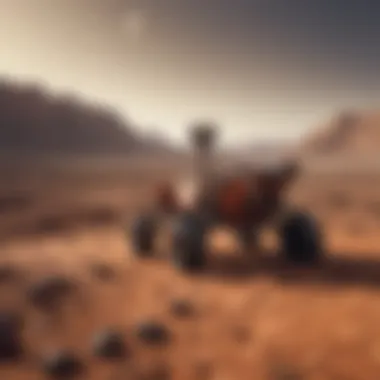Exploring the Role of Space Rovers on Mars


Intro
Space exploration, particularly the study of Mars, has captivated humanity for decades. The advent of space rovers marks a pivotal point in our quest to uncover the mysteries of the Red Planet. Rovers are not merely machines traveling across Martian terrain; they are sophisticated tools designed to analyze geologic structures, climate, and potential signs of life. Their role surpasses basic exploration and extends into the realm of scientific discovery, impacting our understanding of planetary processes and evolution.
In this article, we will delve into the significance of space rovers on Mars, examining their design, operational functionality, and contributions to scientific knowledge. Key missions will be highlighted, providing insights into the technology that enables rovers to navigate and perform their assigned tasks under extreme conditions. The challenges faced by these unmanned vehicles will be addressed, emphasizing their importance in advancing human understanding of Mars and its potential for supporting life.
The narrative aims to synthesize existing research and findings related to Martian rovers, providing an informative overview that appeals to students, researchers, educators, and professionals. Through this exploration, we aim to illuminate the broader implications of rover missions on planetary science, revealing how these robotic pioneers contribute to our knowledge of the cosmos.
Prelude to Mars Exploration
The exploration of Mars stands as a pivotal chapter in the narrative of scientific inquiry. It represents humanity's endeavor to understand worlds beyond our own and to address fundamental questions about the nature of life, the evolution of planets, and our place in the universe. Mars, often dubbed the "Red Planet," has long fascinated astronomers and planetary scientists alike, compelling missions that stretch back decades.
Historically, the allure of Mars can be traced to early observations that hinted at its geographical features. These initial observations laid the groundwork for more advanced exploration efforts. The advent of technology enabling the launch and operation of space rovers has dramatically shifted the landscape of Martian exploration, providing unparalleled data that informs current understanding while guiding future endeavors.
The significance of rovers in this exploration cannot be overstated. They are the key players in this complex endeavor, blending cutting-edge engineering with scientific rigor. Rovers enable prolonged investigation of Martian surface and atmosphere, collecting data in ways that previous methodologies—such as orbiters—could only dream of. With their ability to traverse varied terrains, diagnose mineral compositions, and analyze atmospheric samples, rovers enhance our grasp of Mars's past and present.
This article delves into the numerous aspects of Mars exploration, particularly the role of rovers. What they have achieved already and what they might reveal in future missions composes the heart of ongoing planetary science. Understanding both the historical context and the significance of these robotic pioneers sets the stage for deeper exploration into their design, challenges, and scientific contributions.
Technological Advancements in Rovers
Technological advancements in space rovers play a critical role in enhancing our exploration of Mars. These innovations not only improve the efficiency of rover operations but also expand the scope of scientific inquiry. The continual evolution of rover technology equips them with capabilities that allow for sophisticated tasks in harsh Martian conditions. Various advancements pertain to design, navigation, and instrumentation.
Design and Engineering
The design and engineering of Mars rovers are essential elements that influence their operational success. Rovers like Curiosity and Perseverance incorporate advanced materials and engineering practices. This ensures they can endure extreme temperatures and dust storms. The lightweight yet durable materials used in construction minimize energy consumption, allowing for longer missions.
Additionally, the modular design of components permits easy replacement. When components fail, rovers can maintain functionality instead of becoming entirely inoperative. Such purposeful design choices are pivotal for missions that can span many years, maximizing the scientific return for each dollar invested.
Autonomous Navigation
Autonomous navigation is a significant leap forward in rover capabilities. Mars rovers are equipped with sophisticated algorithms and machine learning techniques to navigate across the Martian terrain. This automation minimizes the need for constant communication with Earth. Large communication delays make real-time operation difficult. Therefore, the ability to make decisions independently is crucial.
Rovers can analyze their surroundings using visual data. The onboard software allows them to identify obstacles and plan efficient paths forward. This is especially important on Mars, where unexpected hazards, such as rocks or steep slopes, can be prevalent. The success of autonomous navigation can be seen in the Perseverance rover, which has been able to travel considerable distances without direct human input.
Scientific Instruments
Scientific instruments on rovers have evolved dramatically, reflecting the growing complexities of Martian exploration. Instruments like the Mastcam and the SuperCam on Perseverance enhance the ability to capture high-resolution images and analyze soil composition from afar. These technologies provide researchers with valuable data without the need for closer, potentially dangerous approaches.
Instruments designed to search for organic molecules are particularly significant. These tools not only assess the geological environment but also investigate signs of past life. They collect data that is sent back to Earth for detailed analysis, expanding our understanding of Mars’ potential for harboring life.
Key Martian Rover Missions
The exploration of Mars has been significantly shaped by the missions of various rovers. Each mission provides insights into the planet's geology, climate, and potential for life. Key Martian rover missions are not just important milestones in space exploration; they serve as a testament to human ingenuity. These missions also pave the way for future explorations, expanding our understanding of Mars and, by extension, our own planet.


Spirit and Opportunity
Mission Goals
The Spirit and Opportunity rovers were launched in 2003 with specific goals focused on understanding Martian geology. A key characteristic of their mission was to explore the surface of Mars for signs of past water. Their twin nature allowed for simultaneous exploration in different locations. This coordination enhanced data collection, a beneficial aspect for comprehensive geological analysis. The unique feature of these rovers was their ability to traverse rugged terrains, enabling them to cover more ground than previous missions.
Major Discoveries
These rovers made significant discoveries concerning the history of water on Martian surface. One major discovery involved the identification of hematite, a mineral that often forms in water, indicating a wetter past. This finding supports theories about ancient Martian environments being more hospitable. Aspects of this discovery continue to impact our understanding of planetary habitability. By examining the rovers' findings, researchers could apply these insights to improve models of Martian climate and geology, enhancing the knowledge base for future missions.
Curiosity
Scientific Objectives
Curiosity's mission objectives were expansive, aiming to assess Mars' habitability and understand its geology and climate. Curiosity is a larger and more advanced rover, featuring a variety of scientific instruments for data collection. One prominent aspect of its mission is the ability to analyze soil and rock samples on-site. This capability gives Curiosity a unique advantage, as it can provide real-time data rather than relying solely on remote analysis.
Findings and Implications
The findings from Curiosity have crucial implications for understanding the potential for life on Mars. For instance, the rover found carbon-containing compounds, which are fundamental to life as we know it. These discoveries are groundbreaking in the search for extraterrestrial life. Moreover, Curiosity’s analyses have led to revisiting existing hypotheses about the planet's climate and environment, confirming some theories while challenging others. The unique capability of Curiosity to conduct varied scientific experiments in situ adds invaluable data to the ongoing study of Mars.
Perseverance
New Technologies
Perseverance, launched in 2020, incorporates cutting-edge technologies that differ significantly from its predecessors. This rover is equipped with advanced navigation tools for improved autonomous movement, allowing it to explore more complex terrains. The key characteristic here is its ability to analyze samples for future return missions. This advancement connects to the overall goal of preparing for subsequent human exploration, as it can store samples for later retrieval.
Search for Signs of Life
One of Perseverance’s principal goals is to search for signs of ancient life and collect samples from the Jezero Crater, where a river once flowed. This mission aspect is particularly compelling as it seeks to find direct evidence of past life forms. The unique feature is its ability to assess biosignatures in Martian rock and soil, offering a more detailed examination than previous missions. The implications of these findings could be profound, reshaping our understanding of life beyond Earth.
Through these missions, humanity not only seeks to discover Martian truths but also reflects on its place in the cosmos.
Challenges of Mars Exploration
Exploring Mars involves significant challenges that test the limits of technology as well as human knowledge. These obstacles range from the extreme environment of the planet to the technical limitations of the rovers which navigate its surface. Understanding these challenges is crucial for the advancement of future missions. Each challenge informs the design and operation of rovers, ensuring that they can survive and operate successfully in such a harsh backdrop.
Harsh Environmental Conditions
Mars presents a variety of harsh environmental conditions that impact rover missions significantly.
Temperature Extremes
Temperature extremes on Mars are one of the most formidable challenges faced by rovers. The average temperature hovers around minus 80 degrees Fahrenheit, but it can plummet to minus 195 degrees at the poles during winter. These extreme cold situations present a substantial obstacle for the materials and technologies used in rover design. Most electronic components are not designed to function in these sub-zero environments, leading to concerns regarding the reliability and longevity of the instruments onboard. This characteristic makes it vital to develop materials that can withstand the fluctuations.
Moreover, this aspect emphasizes the importance of thermal management systems in apace exploration. Effective insulation and heating systems need to be in place to keep essential components operational. Therefore, understanding temperature extremes is a beneficial choice for this article as it highlights both the engineering hurdles and potential solutions for scientists and engineers.


Radiation Challenges
Radiation challenges play a pivotal role in rover missions on Mars. The Martian atmosphere provides some protection against solar and cosmic radiation, but it is still much thinner than Earth's. Rovers must be equipped to protect sensitive instruments and electronic systems from both short-term and long-term exposure to high levels of radiation.
This characteristic is significant because it affects the design of rovers. Shielding materials need to be developed that balance weight and protective capabilities. A unique feature of these challenges is that they also raise questions about the safety of potential future human missions to Mars, expanding the relevance of this topic.
Communication Delays
Communication delays caused by the distance between Mars and Earth complicate mission planning. Signals take approximately 13 to 24 minutes to travel one way, creating a lag that must be accounted for in operations. This necessitates autonomous systems on the rovers to make decisions without immediate input from mission control. The consequence of such delays can impact everything from scientific data collection to routine rover maintenance. This aspect needs consideration when evaluating rover missions, since time-sensitive decisions can greatly influence mission success.
Power Supply Considerations
Power supply considerations are crucial when planning Martian exploration missions. Rovers require a reliable energy source to function over long periods, often utilizing radioisotope thermoelectric generators or solar panels. Each of these sources has advantages and disadvantages. For instance, while solar panels are beneficial in light conditions, they face challenges during dust storms, which can greatly reduce their efficiency.
In summary, the hurdles of exploring Mars outline the multi-faceted difficulties of rover missions. Addressing these challenges can significantly impact the progress of future Martian exploration.
Scientific Discoveries from Rovers
The role of space rovers on Mars has been pivotal in enhancing our understanding of the planet. Through various missions, they have uncovered valuable information that reshapes our view of Martian geology, the potential for past life, and the presence of essential resources. These discoveries not only contribute to planetary science but also lay groundwork for future exploratory missions.
Geological Surveying
Rovers like Curiosity and Perseverance have played crucial roles in geological surveying of Mars. By analyzing rock formations, soil samples, and sediment patterns, they help scientists understand the planet's geological history. This information is vital in identifying past volcanic activity, sedimentary processes, and erosion, which are indicators of Mars's dynamic past.
Furthermore, geological surveys assist in locating potential landing sites for future human exploration. Understanding the composition and structure of the surface can minimize risks and maximize the potential for successful missions.
Search for Water
One of the most significant scientific quests of Mars rovers is the search for water. Water is essential for life as we know it, and its presence could indicate that conditions for life existed on Mars at some point. Rovers have detected signs of ancient riverbeds, lake sediments, and even hydrated minerals that suggest water once flowed on the surface.
In particular, the Perseverance rover is equipped with advanced tools to analyze the composition of Martian rocks and soil, seeking evidence of past water activity. This knowledge can provide insight into Mars's climate history, and if microbial life ever thrived there.
Identifying Organic Molecules
The identification of organic molecules is another area where rovers have made substantial contributions. Organic chemistry forms the basis of all known life on Earth. The presence of organic molecules on Mars, especially in relation to water, raises intriguing questions about possible life forms.
Rovers utilize specialized instruments to carry out detailed analyses, capable of detecting complex organic compounds. Such discoveries may transform our understanding of Mars and its potential habitability. While the existence of organic molecules does not confirm life, it opens up exciting avenues for further research, particularly in understanding the conditions that may have once supported life.
"The discoveries made by the rovers are not merely an academic exercise; they hold implications for our understanding of life beyond Earth."
These scientific discoveries from rovers set forth a new paradigm in space exploration. They not only deepen our knowledge of Mars but also provide critical insights that will guide future explorative efforts, including potential human colonization.
Impact on Future Space Missions
The advancements in Martian rover technology are pivotal in shaping future space missions beyond Mars. The knowledge gained from previous missions is foundational for planning human exploration. Rovers serve as precursors to human presence, gathering essential data about the Martian atmosphere, surface, and potential hazards. This information influences both the design and strategy of subsequent missions.


Foundation for Human Exploration
Rovers like Curiosity and Perseverance have laid groundwork for human exploration by identifying viable landing sites and assessing resources. For instance, data showing the existence of water ice is crucial for future human missions. Water is essential for sustaining life and can be converted into oxygen and hydrogen, making it a valuable resource for astronauts. The in-situ resource utilization technology explored by these rovers is aimed at reducing the payload necessary from Earth.
Moreover, understanding the Martian environment helps us mitigate risks for crewed missions. By analyzing factors such as radiation levels and dust storms through rovers, planners can design safer habitats and operational protocols. Notably, having rovers capable of performing before humans arrive enhances the safety and efficiency of mission strategies.
Development of New Technologies
Rover missions drive innovation by catalyzing the development of new technologies. Each advancement made in rover design, such as improved autonomous navigation algorithms or enhanced scientific instrumentation, can be adapted for various applications in future missions. For example, developments in miniaturized sensors for atmospheric monitoring pave pathways to similar technologies for monitoring terrestrial environments.
Additionally, the challenges encountered on Mars push engineers to refine existing technologies. The need for reliable and long-lasting energy sources has spurred the creation of more efficient solar panels and novel power storage systems. Such innovations are not only applicable to future rover missions but hold potential for improving energy solutions on Earth.
"The ingenuity developed through rover missions serves as a breeding ground for technologies that can transform the way we explore space and live on Earth."
Ethical Considerations in Rover Missions
The exploration of Mars through robotic rovers raises several ethical considerations that merit serious discussion. As we push the boundaries of technology to learn more about our neighboring planet, we also carry the responsibility for its protection and preservation. Ethical considerations guide the decision-making processes that affect not only scientific outcomes but also the future integrity of Martian environments.
Planetary Protection
Planetary protection refers to the measures taken to prevent contamination of extraterrestrial environments by Earth organisms, as well as to avoid any potential impacts that these environments might have on humanity. This concern is particularly relevant in the context of Mars exploration. The presence of Earth microbes on Mars could complicate the search for indigenous life forms. If we do discover life on Mars, it would be challenging to determine whether it originated from Mars or was brought there by past missions.
To uphold the principles of planetary protection, strict sterilization protocols are employed during the construction and transport of rovers. For example, the Curiosity rover underwent thorough cleaning processes to minimize the risk of microbial contamination. These protocols not only ensure that scientific results are not tainted, but they also reflect our respect for Martian ecosystems. The ethical obligation here is clear: we must safeguard Mars as much as we seek to understand it.
Preservation of Martian Environments
As we deploy rovers across the Martian landscape, the potential impacts on the environment cannot be overlooked. Preservation of Martian environments involves careful consideration of how rover activities might affect both the physical landscape and any existing microbial life. The technical design of rovers aims to minimize disruption, but such efforts must align with ethical standards.
Human-like footprints on another planet raise questions about our right to alter or disturb untouched landscapes. Each rover mission must balance the pursuit of scientific knowledge with the possibility of causing irreparable damage. The adherence to ethical standards ensures that the exploration missions do not treat Mars merely as a testbed or a resource.
"Exploration is not enough; we must pursue it with respect for the worlds we explore."
The ongoing discussions about planetary protection and environmental preservation are critical for fostering an ethical framework that governs future Mars missions. It is essential that researchers, policymakers, and the scientific community engage in meaningful dialogue regarding these ethical obligations.
Culmination
In this article, the exploration of the role of space rovers on Mars reveals the profound impact these machines have on our understanding of the planet and its history. The journey through various missions illustrates how rovers have not only gathered critical data but have also paved the way for future exploration.
Summary of Rover Contributions
The contributions of Mars rovers are numerous and varied. They have performed essential tasks such as geological surveys, searching for water, and identifying organic molecules, which are crucial for determining the planet’s potential to support life. Key missions like Spirit, Opportunity, Curiosity, and Perseverance have produced a wealth of findings that inform scientists about Mars' environment, climate, and past. The data collected has improved our understanding of planetary processes and can lead to vital discoveries that relate to Earth itself.
Rovers have also showcased advancements in technology. Through their design, autonomy, and scientific instruments, they have allowed us to reach new heights in space exploration. The development of new technologies, especially in autonomous systems and power supply, is directly linked to the needs of Mars exploration.
Future Directions in Mars Research
Looking ahead, the future of Mars research is promising. The ongoing successes of rover missions will likely lead to new missions targeting specific scientific questions. Future rovers may integrate even more advanced technologies, enhancing our ability to analyze samples in situ. Research areas such as astrobiology and planetary geology will benefit from continued rover missions.
Moreover, as we prepare for human exploration, insights gained from rovers are essential. They lay the foundation for understanding the Martian surface and environment, ensuring that we can safely navigate and utilize resources on the planet. Continuously updated data from rovers may also aid future astronauts in planning their journeys and settlements.
In summary, rovers serve not only as tools for exploration but also as catalysts for human understanding and technological evolution in space science. Their contributions to Mars research and the framework they provide for future missions are invaluable and will keep shaping our approach to planetary exploration.















